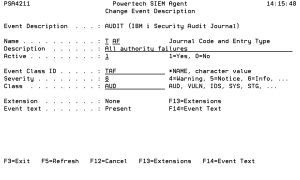Change Event Description panel
The Change Event Description panel allows you to modify the properties of an existing Event Description.
How to Get There
Enter 2=Change for an entry in the Work with Event Descriptions panel.
Field Descriptions
Event Source
An Event Source is a location from which IBM i events are extracted. Currently, journals and message queues are supported as Event Sources. Common event sources are QAUDJRN (journal) and QSYSOPR (message queue). You may define your own journals and message queues as Event Sources.
Name
The name you use to refer to this Event Description within Powertech SIEM Agent. For events that originate in a journal, this name must be comprised of the Journal Code and Entry Type of the journal entry. For message queue events, this name must be a message ID.
Description
A short description you assign to the Event Description.
Active
Indicates whether the Event Description is available for processing. When an Event Description is not active, the event it identifies will not be processed.
Event Class ID
Event Class ID is simply placed into the syslog output event when using the Legacy Interact 3 Syslog format. Interact 3 formatted this data as a message ID, but you are free to specify whatever data is meaningful to you.
Specify *NAME to display the Event Description's Name in the output. For journals, this is the Journal Code and Entry Type (for example, TCD). For message queues, *NAME displays the Message ID (for example, CPF0907).
You can specify a single asterisk (*) to inherit the value from the parent Event Description at run time.
Severity
Indicates the severity of the event. This severity is used in the output syslog packet.
Class
Class is simply placed into the syslog output event when using the Legacy Interact 3 formats. Typical values implemented by Interact 3 include:
Extension
At the Event Description level, the Extension field defines the default Extensions. Additional Extensions can be added for individual Subtypes and Rules defined within the Event Description, for example, those specified in the Add Extension field of the respective Create Event Subtype panel and Create Rule panel.
Event Text
At the Event Description level, this field defines the default Event Text for the Event Description. If you leave this field blank, most Events will have blank Event Text. The Event Text for Subtypes and Rules defined within this Event Description can be overridden using the Override Event Text field in, for example, the respective Create Event Subtype panel and Create Rule panel.
Command Keys
F3=Exit
Exit the program.
F4=Prompt
Displays a list of items from which one or more may be selected.
F5=Refresh
Discards changes and remains on this panel.
F12=Cancel
Discards changes and returns to the prior panel.
